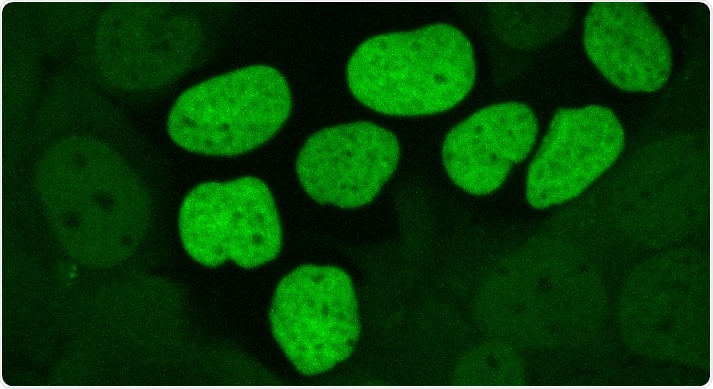Each cell in the human body continuously divides to create new cells. This process occurs without humans’ knowledge. But each time a cell divides, a complex process has to unfold in just the right way for human cells to prevent illness and death.

The glowing cells have the babysitter protein present while the other cells are genetically modified to lack it. Image Credit: University of Copenhagen.
DNA replication is the most critical stage in this process, where the DNA found in a mother cell is duplicated into its two daughter cells. Here, several molecules have to work collectively to assemble a par of new, identical strings of DNA.
Writing for a leading international journal Nature, scientists from the University of Copenhagen have identified how MCM proteins make sure that DNA replication continues at the right speed and therefore prevents unwanted molecular collisions, which could cause damage to their genomes.
Even more significantly, the new study demonstrates how mother cells are able to instruct the daughter cells to maintain the speed of their DNA replication within physiological limits. In other words, the new findings identified nothing less than how a crucial skill needed for continuing life is stored in the memory of a cell.
We have quite many of these MCM proteins inside our cells. We can see them in the microscope, but for decades, scientists did not know what the vast majority of them actually do. From an evolutionary standpoint, it did not make sense to maintain a huge surplus of proteins only as back up, with no other important function. We have now solved this ‘MCM paradox’ by finding that all those many MCM proteins in our cells actually have a defined function”
Hana Sedlackova, Study First Author and PhD Student, Novo Nordisk Foundation Center for Protein Research
Exploiting cancer weaknesses
To elaborate on the new findings by an analogy, the team observed that cells use the excess of young MCM proteins to delay the DNA replication and they do this by adding “speed bumps” ahead of their older siblings that “drive” the engine of DNA replication. Although it may seem unrealistic to delay the process, there is a very good reason for the body to do so.
These new results show that most of MCM proteins work a bit like speed bumps on a busy street. If they were not there, the traffic would go too fast and accidents could easily happen. Our study shows that the same thing happens in the cell: If the newly born MCM proteins cannot be passed by other cells on to their daughters, DNA is replicated too quickly, and this can be fatal for the cell. Just like a car, the DNA replication engine loses its maneuverability when it goes too fast.”
Jiri Lukas, Professor and Executive Director, Novo Nordisk Foundation Center for Protein Research
According to the researchers, their findings may probably help manipulate the shortcomings of cancer cells.
Lukas added “During our work, we have also found that the young MCM proteins require a ‘molecular babysitter’ (a protein called MCMBP), which protects them and escorts them to DNA, where they can be useful. Without such protection, molecular roadblocks that slow down DNA replication cannot be made.”
While DNA in normal cell can be viewed as a nice new highway that allows reasonably fast speed, DNA in cancer cells is riddled by ‘potholes’, where every fast car (or a molecular motor that replicates DNA) is bound to crash. Based on our new findings, we are currently testing the idea that genetic of pharmacological removal of the MCMBP, and the resulting high speed of DNA replication, can be tolerated by normal cells but lethal to cancer cells.”
Jiri Lukas, Professor and Executive Director, Novo Nordisk Foundation Center for Protein Research
The team managed to plot the proteins and identify their role by employing a range of advanced equipment, like HaloTag and CRISPR-Cas9. They subsequently used 4D imaging to label the native MCM proteins and watched how they are born in the mother cells and how they are inherited by daughter cells. The team also noted how the functions of these proteins are modified in the absence of MCMBP—the “MCM babysitter.”
Source:
Journal reference:
Sedlackova, H., et al. (2020) Equilibrium between nascent and parental MCM proteins protects replicating genomes. Nature. doi.org/10.1038/s41586-020-2842-3.